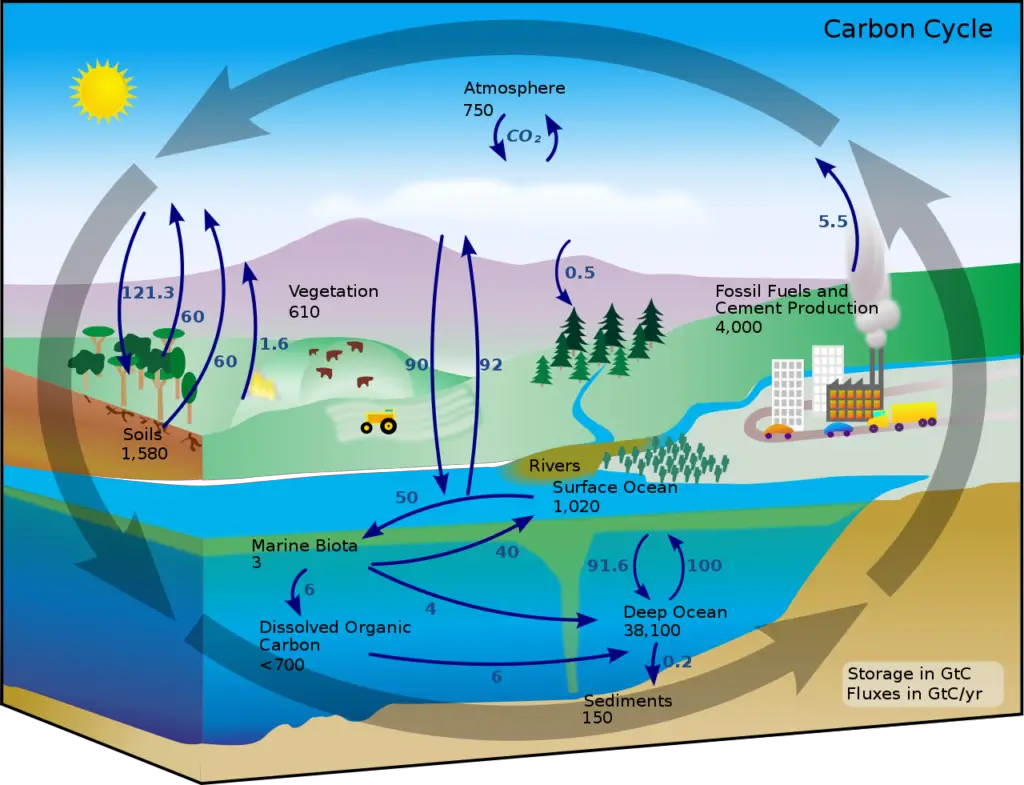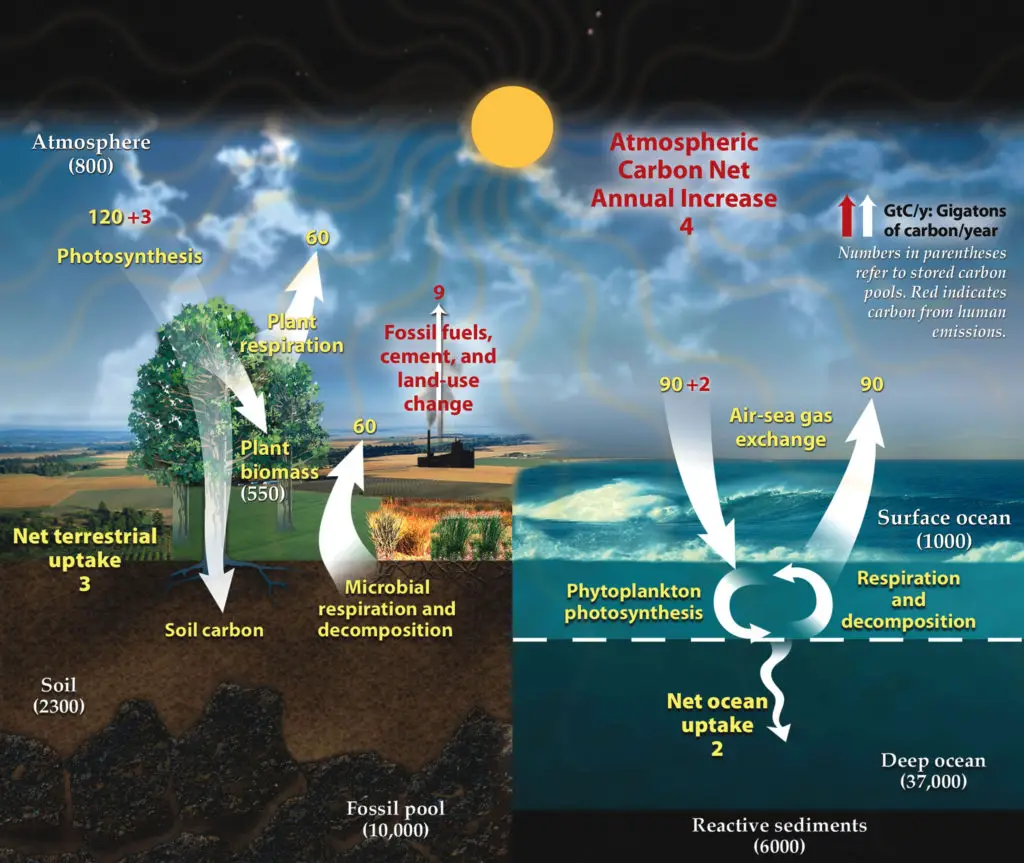Is The Atmosphere a Carbon Sink or Source?
The atmosphere is an intermediate form of carbon sink and source. So, it will be more correct to call it the storehouse of carbon. Carbon is constantly moving in and from the atmospheric storehouse thus making it work both as a sink and a source of carbon.
The atmosphere helps recycle Carbon dioxide and Methane on Earth via. the carbon cycle, thus bringing the presence of carbon throughout the globe.
Processes that release Carbon dioxide to the atmosphere are called carbon “sources”, while processes that absorb it are called carbon “sinks”.
The atmosphere acts as both as carbon source and sink and highly helps in recycling carbon.
Forests, soil, oceans, atmosphere, and fossil fuels are all important stores of carbon. The atmosphere remains in close association with the other stores in order to exchange carbon and take part in the carbon cycle efficiently.
The Carbon is constantly moving between these different stores, that act as either “sinks” or “sources.” Thus, making the proper carbon flow amidst all living and non-living forms as it always has been going on over the course of time.
So, how much carbon dioxide is actually there in the atmosphere? The concentration of carbon dioxide in Earth’s atmosphere is currently at nearly 412 parts per million (ppm) and rising.
The atomosphere actually has the most limited amount of carbon in the whole carbon cycle, and is always involved in the process of absorbing and emitting carbon.
The amount of carbon is always at the state of equilibrium all throughout the surface of the earth. Thus, the carbon dioxide in the atmosphere at any one time depends on the balance that exists between the sinks and sources.
This system of sinks and sources operates and is ongoing all over the planet and is known as the carbon cycle.
The hydrosphere, lithosphere, and atmosphere are the top three important stores of carbon that act as both sink or source making the carbon cycle possible.

Why is the atmosphere a carbon source?
A carbon source is something that emits carbon and gives it to the other participants in the carbon cycle. A carbon source is always shrinking in size and releasing more carbon. A source always emits more than it absorbs.
Carbon is stored in the atmosphere as carbon dioxide, methane, etc. which it gets from other sources like due to the burning of fossil fuels, due to respiration, etc.
The process that leads to the increase in atmospheric carbon is both due to the natural and human sources of carbon dioxide emissions.
Natural sources include decomposition, ocean release, and respiration. Human sources come from activities like cement production, deforestation, burning of fossil fuels like coal, oil, and natural gas.
This results in the constant increase in carbon in the atmosphere which is in turn are emitted back to the cycle.
Just like when the plants do photosynthesis they take the carbon dioxide from the atmosphere (a carbon source) which passes to the humans, soil, etc. as part of the carbon cycle.
In simple words, the atmosphere is termed as a carbon source because it itself has a lot of carbon moving freely which it had received from other carbon sources and, this atmospheric carbon is emitted back to the plants, oceans, etc. through the carbon cycle.

Why is the atmosphere a carbon sink?
A carbon sink is anything that absorbs more carbon than it actually emits as carbon dioxide. A sink is a perfect reservoir of carbon that is always available in the atmosphere.
However, it’s very rare for the atmosphere of a particular place to become a carbon sink. It’s because the amount of carbon the atmosphere emits is always more than what it absorbs.
And only when the balance of the carbon cycle and the ecosystem is disturbed the atmosphere acts more like a carbon sink.
Just like after the industrial revolution, this balance has shifted and the equilibrium is not maintained. As a result, extra carbon is going into the atmosphere due to the massive level of industrialization.
The processes of the carbon cycle which add extra carbon to the atmosphere are known as sources, and processes which take carbon dioxide from the atmosphere and store it are known as carbon sinks.
However, it is seen that the atmospheric carbon dioxide level is increasing more and more, and more amount of carbon is getting stored in the atmosphere day by day than its actually emitted. Thus, this is making the atmosphere more like a carbon sink.
But, in those places where there are more trees and forests than the industries, the carbon cycle is still in equilibrium. And so there the atmosphere acts like a carbon source and not like a sink.

Atmosphere as a Carbon Sink or Source
1. When the atmosphere emits more carbon than it actually actually absorbs, it becomes a carbon source. On the other hand, when the atmosphere absorbs more carbon than it actually emits, it becomes a carbon sink.
2. The photosynthetic plants help absorb carbon from the atmosphere as carbon dioxide and brings carbon in the carbon cycle. On the other hand, the industries, burning of fossil fuels, etc. release carbon into the atmosphere to become carbon dioxide, methane, etc.
3. In places where there are less photosynthetic trees to absorb the carbon, the atmosphere becomes a carbon sink. While in places, where there are more photosynthetic trees than the carbon releasers (like vehicles, industries, etc.), the atmosphere becomes a carbon source.
4. In the ocean ecosystem, the ocean water absorbs a lot of carbon along with the phytoplankton from the atmosphere. Thus, bringing dissolved carbon in water in the form of carbon dioxide. This makes oceans as a carbon sink and the atmosphere as a carbon source.
5. Carbon dioxide absorbs and reflects radiation of the sun back to earth. It doesn’t allow the radiation to be sent back into space. Thus, leading to Global Warming. So, in places of atmospheric carbon sink, the temperature of the place constantly increases due to global warming.
6. The atmosphere both as the source and sink is very necessary. The atmosphere is the most open and free storage of carbon to all forms of the globe. The atmospheric storage of carbon is available to all. The carbon is emitted by the atmosphere and get back to it following a series of the carbon cycle in equilibrium.
CONCLUSION
Thus, it’s very clear that the atmosphere acts both as a source and a sink.
And, it will be more than perfect to call the atmosphere as an intermediate form of carbon storage between the source and sink, when the carbon cycle is in equilibrium.
But, if anyhow the equilibrium of the cycle is changed then, the atmosphere can shift towards becoming a more carbon sink or a more carbon source type.
So, it’s always important that we maintain the balance in the ecosystem and so the equlibrium.
Just, for example, over-forestation can lead to more absorbance of carbon dioxide from the atmosphere making the atmosphere a carbon source and the tress a carbon sink.
In the other case, over-industrialization can lead to more availability of carbon in the atmosphere than its emitted. Thus, making the atmosphere more of a carbon sink and the industries, factories, etc. as carbon source.
Hope that you got your answer cleared!
